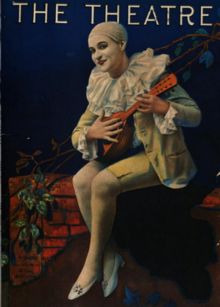Marjorie Patterson

Marjorie Patterson (May 12, 1886[1] – March 11, 1948) was an American author and actress in the early 20th century.
Her works included the novels Fortunata (1911),[2][3][4] The Dust of the Road (1913), about her experiences acting in London,[5][6] and A Woman's Man (1919).[7][8]
Publishers Weekly provided this summary of Fortunata in 1911: "Fortunata is the granddaughter of an old Roman Princess and lives in a great Roman palace. When about 18 she begins to have her own way. She spends money lavishly, associates with most unhealthy companions for a young girl. Finally she drifts to England and marries a very rich man and is forced to live with his hum-drum mother and daughters. The Italian wife remains erratic and the end is tragedy."[9] H.L. Mencken gave the book a positive review.[10]
Patterson's theatre roles included playing the title role in Pierrot the Prodigal (which played at the Booth Theatre in New York and was produced by Winthrop Ames and Walter Knight),[11][12] and in the one-act Pan in Ambush, which she wrote.[13] She also acted for a few years in England.[14][15][16][17][18]
Reporting on her in the 1910s places her birth year around 1891; it was not uncommon at this time for actresses to claim a younger age. Attention to her doings dropped off by about 1922, and there is little subsequent mention of her after that time.
Patterson was the only daughter of Wilson Patterson and Margaret Sherwood. Her great-grandfather was author and critic John Neal,[1] and her great-aunt was Elizabeth Patterson Bonaparte, sister-in-law of Napoleon.[3][19] She lived her later years in New York City where she died of hepatitis.
Bibliography
[edit]- Fortunata: a novel (February 1911, Harper & Bros.)
- The Dust of the Road (1913)
- A Woman's Man (1919)
- Pan in Ambush (1916) (one act play)
References
[edit]- ^ a b Richards, Irving T. (1933). The Life and Works of John Neal (PhD). Harvard University. pp. 1275–1276. OCLC 7588473.
- ^ Gaines, C.H. (February 1911). Harper's Bookshelf, Harper's Magazine, Vol. 122, p. 488-89
- ^ a b (September 1911). Chronicle and Comment, The Bookman (New York), Vol. 34, No. 1, p. 9
- ^ (4 March 1911). Book review, Pittsburgh Press
- ^ (8 December 1912). Miss Patterson Rests After Writing Book on English Theatricals, Washington Herald
- ^ (8 November 1913). The Bellman's Bookshelf, The Bellman, p. 596
- ^ (1 November 1919). Three Woman Novelists, The Nation
- ^ American Fiction, 1901-1925: A Bibliography, p. 520 (Cambridge Univ. Press 1997)
- ^ (25 February 1911). Review, Publishers Weekly
- ^ (June 1911). The Horse Power of Realism, The Smart Set, p. 153-54
- ^ (November 1916). Pierrot the Prodigal, Green Book Magazine
- ^ (16 December 1916). Brooklyn Life (cover photo), Brooklyn Life
- ^ "Pan in Ambush". Great War Theatre. Retrieved 2024-08-08.
- ^ (4 November 1921). Girls Greatest Gifts All Belong To Her, Southeast Missourian
- ^ (30 March 1918). Vagabond Players of Baltimore, The Dramatic Mirror, p. 30
- ^ (7 February 1916). Acts in Play She Wrote: Miss Marjorie Patterson Presents "Pan in Ambush" in London, The New York Times
- ^ (14 June 1914). Miss Patterson's Success: Member of Baltimore Family Praised for Her Acting, The New York Times
- ^ (30 April 1913). Foreign Notes, New York Dramatic Mirror, p. 11, col. 1
- ^ (July 1908). Types of Fair Women, The Scrap Book, Vol. 6, No. 1, p. 85, 87
External links
[edit]- Works by or about Marjorie Patterson at the Internet Archive
- Marjorie Patterson at the Internet Broadway Database
- Fortunata (Harper & Bros., 1911)
- The Dust of the Road (Henry Holt, 1913)
- A Woman's Man (1919)
- Pan in Ambush (play, published 1921)
